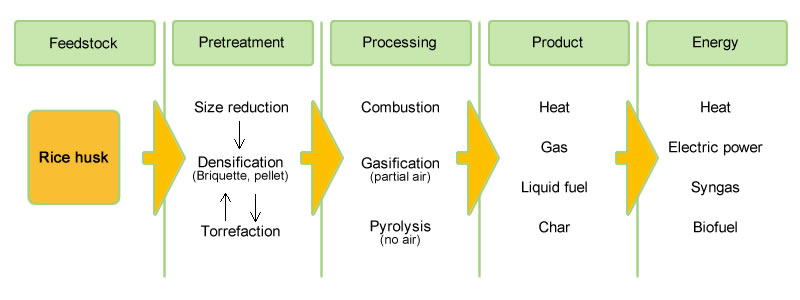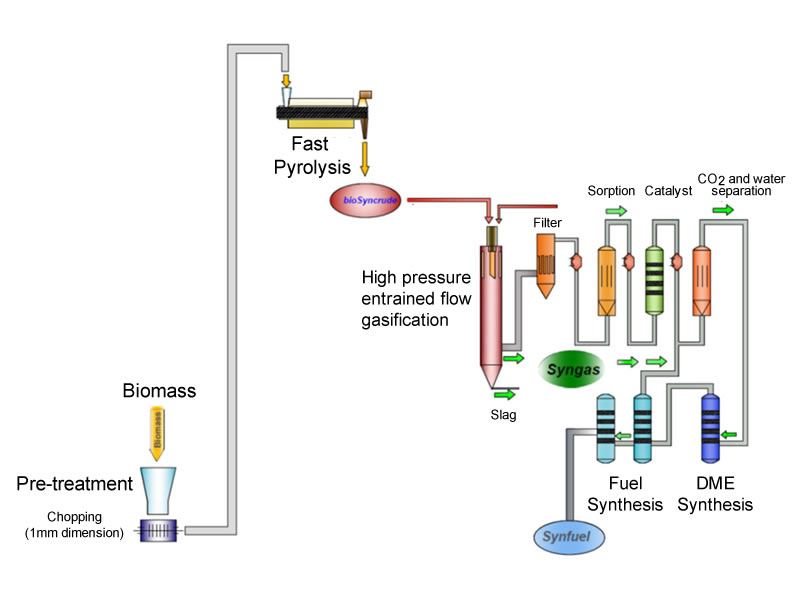Using rice husk for energy production
Rice husk contains about 30–50% of organic carbon and have high heat value of 13–16 MJ per kg. It can be used to generate fuel, heat, or electricity through thermal, chemical, or bioprocesses. The energy conversion processes of rice husk are presented in a diagram in Figure 1.

Fig.1. Process route of energy from rice husk.
Rice husk is collected after rice milling, with moisture content of about 14–15%. This fits the requirement for further pretreatment or processing. Thermal processes, including combustion, gasification, and pyrolysis, are applied for rice husk processing. Energy products from rice husk are heat, electricity, and biofuel (solid or liquid). Heat generated from this could be used for house heating and cooking, industrial boilers, drying, and generating electricity. Figure 2 shows a schematic diagram of a combined system for processing biomass, including mechanical pretreatment, pyrolysis, gasification, and gas refinery. This system has been observed in the UK recently and known as the newest technology for biofuel conversion from biomass.

Fig. 2. Biofuel process route of biomass.
The following is a summary of the characteristics of rice husk compared with other solid fuels in terms of energy use:
- Its high silica content causes the wearing of the components in processing machines, such as the chopper or grinder. Content of volatile matter in rice husk is higher than in wood and much higher than in coal, whereas fixed carbon is much lower than in coal. Ash content in rice husk is much higher than in wood and coal, which cause barriers for energy conversion (Jenkins 1998).
- Its high content of ash, alkali, and potassium causes agglomeration, fouling, and melting in the components of combustors or boilers (Baker 2000).
Available solution to solve barriers in energy conversion from rice husk is pretreatment. Rice husk could be pretreated through mechanical, physical, and chemical means and through bioprocessing, or a combination of these processes to increase efficiency in further energy conversion. These pretreatment technologies can be referred to in Klass (1998), Baker (2000), and Sadaka and Negi (2009). Other solutions for ash-related problems in rice husk are: to combine this with other fuels that are lower in alkali and chlorine (Tillman, 2000), to reduce the temperature in combustion systems, and to use other types of conversion systems such as Organic Rankin Cycle (ORC) and two-stage combustion.
References
Baker R. 2000. Biomass fuel leaching for the control of fouling, slagging, and agglomeration in biomass power generation. PhD Dissertation, University of Califonia.
Jenkins BM. 1998. Physical properties of biomass. In: Kitani O, Hall CW, editors. Biomass Handbook. Gordon and Breach, New York.
Klass L. 1998. Biomass for Renewable Energy and Fuels. Barrington, Illinois (United States): Entech International, Inc.
Sadaka S, Negi S. 2009. Improvements of biomass physical and thermochemical characteristics via torrefaction process. Environ. Prog. Sustainable Energ. 28(3). http://www.scopus.com/inward/record.url?eid=2-s2.0.
Tillman DA. 2000. Biomass co-firing: the technology, the experience, the combustion consequences. Biomass Bioenergy 19:365-384.







